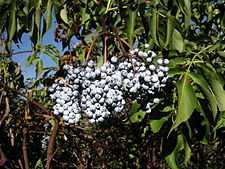Sambucus cerulea
| Sambucus cerulea Sambucus nigra subsp. cerulea | |
|---|---|
 | |
| Scientific classification | |
| Kingdom: | Plantae |
| (unranked): | Angiosperms |
| (unranked): | Eudicots |
| (unranked): | Asterids |
| Order: | Dipsacales |
| Family: | Adoxaceae |
| Genus: | Sambucus |
| Species: | S. cerulea |
| Binomial name | |
| Sambucus cerulea | |
 | |
| Natural range of Sambucus cerulea including S. velutina in lighter blue | |
| Synonyms | |
|
Sambucus nigra subsp. cerulea | |
Sambucus cerulea or Sambucus nigra ssp. cerulea, with the common names blue elderberry and blue elder, is a coarse textured shrub species of elder in the family Adoxaceae. [1][2][3]
Taxonomy
The taxonomy of this species is not finalized, and it is classified by several different botanical names besides Sambucus cerulea. Both the current USDA database and The Jepson Manual of California flora (2013) classify the plant as Sambucus nigra ssp. cerulea. [1][2]
The Sunset Western Garden Book identifies the plant as Sambucus mexicana, and note use of Sambucus caerulea also.[4][5]
The botanist Victor King Chesnut (1867-1938) had classified it as Sambucus glauca in 1902, when studying the plants used by the Indigenous peoples of California in Mendocino County.[6]
Distribution
Sambucus cerulea is native to the Western United States, northern Mexico, and British Columbia. It is found from the Pacific coasts, through California and the Great Basin, to Montana, Wyoming, and Texas. [1][2]
This species grows at elevations below 3,000 metres (9,800 ft), in diverse habits of mountains and hills, valleys, riparian zones, open places in woodlands and forests, and exposed slopes where moisture is reachable. [3][2]
Description
Sambucus cerulea is a large, deciduous shrub, which can grow to be 9 metres (30 ft) in height and 6 metres (20 ft) in width. It is distinguishable from other elderberries by the glaucous powder coating on its bluish-black berries. It normally grows rather wildly from several stems, which can be heavily pruned (or even cut to the ground) during winter dormancy.
The leaves are hairless, strongly pointed and sharp-toothed. They are elliptical to lanceolate, and the blade extends unequally on the stalk at the base. The leaves are commonly 3–15 cm (~1-6in) long and 2–6 cm (~1-2in) wide.
The white or creamy coloured flowers, occurring May to June, are numerous and form a flat-topped cluster usually about 5–20 cm (2–8 in) wide. They are umbel-shaped, normally with 4 to 5 rays extending from the base. The flowers have a strong, unpleasant odor. Individual flowers are 4–7 mm wide.
The fruits given are berry-like drupes. They are juicy, round, and approximately 4–6 mm in diameter. They are bluish-black appearing as a pale powdery blue colour. Each fruit contains 3 to 5 small seed-like stones, each enclosing a single seed.

Uses
Native American
The indigenous peoples of North America, with the plant in their homelands, used the leaves, blossoms, bark, roots, and wood for preparing traditional medicinal remedies, taken internally or applied externally. [7] The fresh, dried, and cooked berries were used for food. [7]
Some tribes used the wood to make musical instruments, such as flutes, clappers, and small whistles; and smoking implements. [7] Soft wood was used as a "twirling stick" to make fire by friction. [7] Stems and berries were used as a dye for basket weaving materials. [7]
The Concow tribe of the Mendocino region called the plant nō-kōm-hē-i′-nē in the Konkow language.[6]
Cultivation
Sambucus nigra ssp. cerulea is cultivated as an ornamental plant by plant nurseries, for planting in traditional, native plant, and habitat gardens. It is also used for natural landscaping and habitat restoration projects. [8] It can become a multi-trunk tree when trained from youth with only several dominant trunks.[4]
The plant is beneficial in wildlife gardens, its flowers attract pollinators, butterflies and hummingbirds, and its berries feed other bird species and chipmunks. [8]
See also
References
- ↑ 1.0 1.1 1.2 USDA . accessed 1.14.2014
- ↑ 2.0 2.1 2.2 2.3 Jepson eFlora . accessed 1.14.2014
- ↑ 3.0 3.1 Montana Plant Life. "Sambucus cerulea Raf." Accessed August 2011.
- ↑ 4.0 4.1 Sunset editors. "Western Garden Book". Sunset Publishing Corporation, 2001, pages 597-598.
- ↑ Jim Conrad. "Blue Elderberries". Naturalist Newsletter, 2009. Accessed August 2011.
- ↑ 6.0 6.1 Chesnut, Victor King (1902). Plants used by the Indians of Mendocino County, California. Government Printing Office. p. 407. Retrieved 24 August 2012.
- ↑ 7.0 7.1 7.2 7.3 7.4 Univ. of Michigan, Dearborn: Ethnobotany of Sambucus nigra ssp. cerulea
- ↑ 8.0 8.1 Las Pilitas Horticultural Database: Sambucus caerulea, Blue Elderberry) . accessed 1.14.2014
External links
- CalFlora Database: Sambucus nigra ssp. cerulea (blue elderberry)
- Jepson Manual Treatment for Sambucus cerulea subsp. caerulea
- USDA Plants Profile for Sambucus nigra ssp. cerulea (blue elderberry)
| Wikimedia Commons has media related to Sambucus cerulea. |